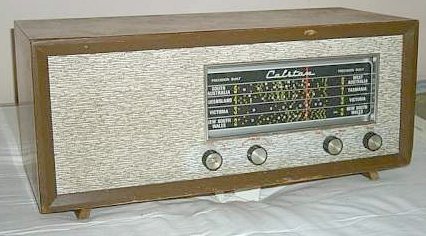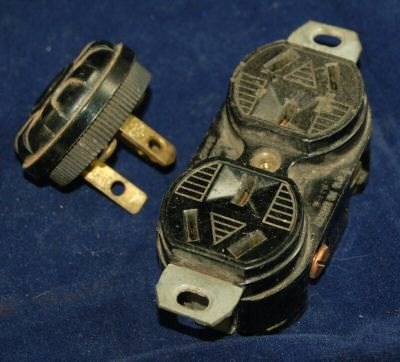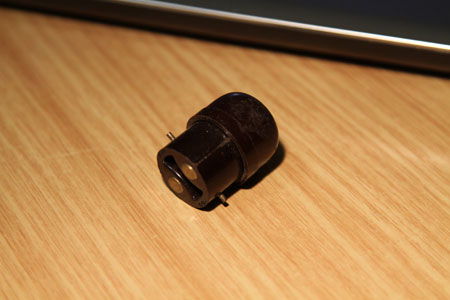Member Introductions
Forum home - Go back to Member Introductions
|
New member from the USA, radio collector
|
|
|
« Back ·
1 ·
Next »
|
|
|
Return to top of page · Post #: 1 · Written at 11:05:10 AM on 2 April 2010.
|
|
|
|
Location: Oradell, US
Member since 2 April 2010 Member #: 643 Postcount: 835 |
|
Hi, Bob from New Jersey (in a suburb of New York City). Been collecting old radios for years. Mostly 5 tube AM radios, and many solid state ones. Mostly American ones, though I have a "Calstan" from Australia.  It works well, and is quite happy with 240V  60Hz here. (American homes are fed center-tapped 240V, small loads use 120V, big loads 240V). 60Hz here. (American homes are fed center-tapped 240V, small loads use 120V, big loads 240V). Speaking of electricity, you may find it amusing that we used to use outlets that look like and will accept Australian plugs.  I have one of these connected to our 240V  60Hz feeding the above Calstan. However it doesn't receive any of the stations listed on its dial 60Hz feeding the above Calstan. However it doesn't receive any of the stations listed on its dial  My web page of radios: http://www.wa2ise.com/. |
|
|
Return to top of page · Post #: 2 · Written at 2:40:23 PM on 2 April 2010.
|
|
|
|
Administrator
Location: Naremburn, NSW
Member since 15 November 2005 Member #: 1 Postcount: 7559 |
|
G'day Bob, ‾‾‾‾‾‾‾‾‾‾‾‾‾‾‾‾‾‾‾‾‾‾‾‾‾‾‾‾‾‾‾‾‾‾‾‾‾‾‾‾‾‾‾‾‾‾‾‾‾‾‾‾‾‾‾‾‾‾‾‾‾‾‾‾‾‾‾‾ A valve a day keeps the transistor away... |
|
|
Return to top of page · Post #: 3 · Written at 4:00:48 PM on 2 April 2010.
|
|
|
|
Location: Oradell, US
Member since 2 April 2010 Member #: 643 Postcount: 835 |
|
Hi Brad, I found an old American patent, number 1,179,728 issued in 1916, which shows an Australian style outlet and plug.  (If that doesn't work, go to the Electrical Contractors' Network web page. Figured that that would be interesting for your article on Australian plugs. My Calstan radio is a transistorized set, using circuit boards. The circuits look to be a "borrowed" design from a portable radio, with a power transformer and supply added. |
|
|
Return to top of page · Post #: 4 · Written at 6:54:20 PM on 2 April 2010.
|
|
|
|
Administrator
Location: Naremburn, NSW
Member since 15 November 2005 Member #: 1 Postcount: 7559 |
|
Figure 2 looks interesting. It appears to be a lamp base-three pin socket adaptor and it would have had the same problem as the Australian bayonet adaptor which was introduced for pretty much the same purpose - no earth connection.  This plug was still being fitted to Australian radios in the late 1940s though the three pin plug was also an option as it had already taken over as the standard way of connecting appliances to the mains by then. That said, radios were still unearthed here until the 1960s. ‾‾‾‾‾‾‾‾‾‾‾‾‾‾‾‾‾‾‾‾‾‾‾‾‾‾‾‾‾‾‾‾‾‾‾‾‾‾‾‾‾‾‾‾‾‾‾‾‾‾‾‾‾‾‾‾‾‾‾‾‾‾‾‾‾‾‾‾ A valve a day keeps the transistor away... |
|
|
« Back ·
1 ·
Next »
|
|
|
You need to be a member to post comments on this forum.
|
|

Sign In

Vintage Radio and Television is proudly brought to you by an era where things were built with pride and made to last.
DISCLAIMER: Valve radios and televisions contain voltages that can deliver lethal shocks. You should not attempt to work on a valve radio or other electrical appliances unless you know exactly what you are doing and have gained some experience with electronics and working around high voltages. The owner, administrators and staff of Vintage Radio & Television will accept no liability for any damage, injury or loss of life that comes as a result of your use or mis-use of information on this website. Please read our Safety Warning before using this website.
WARNING: Under no circumstances should you ever apply power to a vintage radio, television or other electrical appliance you have acquired without first having it checked and serviced by an experienced person. Also, at no time should any appliance be connected to an electricity supply if the power cord is damaged. If in doubt, do not apply power.
Shintara - Keepin' It Real · VileSilencer - Maintain The Rage

